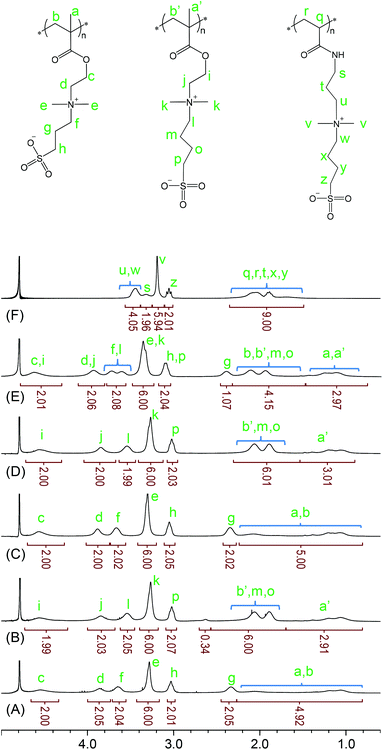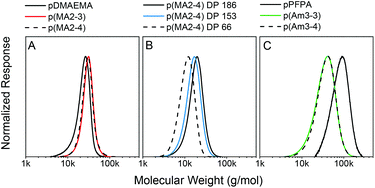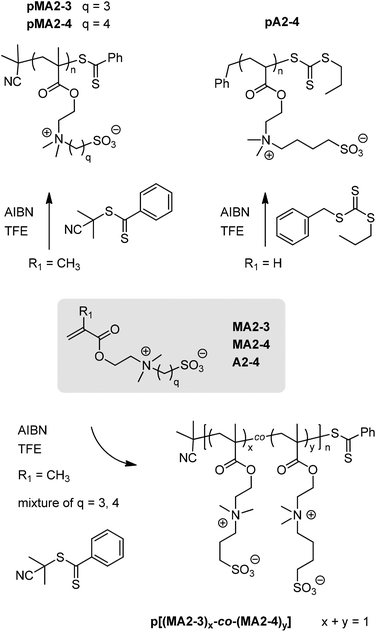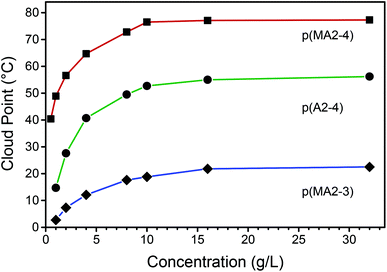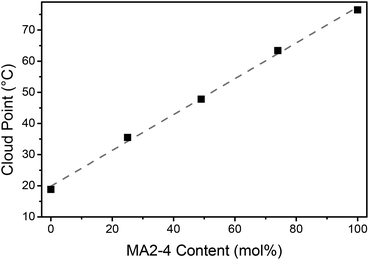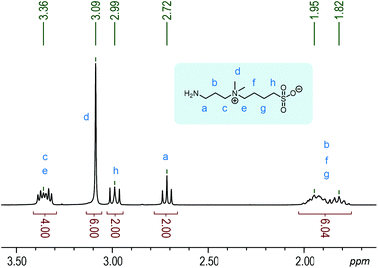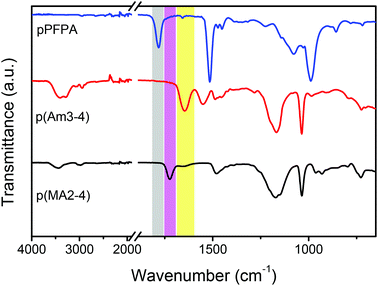 Open Access Article
Open Access ArticleThe synthesis and aqueous solution properties of sulfobutylbetaine (co)polymers: comparison of synthetic routes and tuneable upper critical solution temperatures†
Yicheng
Zhu
,
Janina-Miriam
Noy‡
,
Andrew B.
Lowe‡
and
Peter J.
Roth‡
*
Centre for Advanced Macromolecular Design (CAMD), School of Chemical Engineering, University of New South Wales, Kensington, Sydney, NSW 2052, Australia. E-mail: Peter.Roth@curtin.edu.au
First published on 15th April 2015
Abstract
Polysulfobutylbetaine (SBB) (co)polymers, zwitterionic species bearing ammonium and sulfonate groups separated by a butyl spacer in every repeat unit, were prepared through three different synthetic routes and their aqueous solution behaviour was studied. Postpolymerization quaternization of poly[2-(dimethylamino)ethyl methacrylate] with 1,4-butanesultone resulted in incomplete modification due to the low reactivity of this alkylating agent. RAFT radical polymerization of SBB-functional (meth)acrylate monomers and their copolymerization with a sulfopropylbetaine (SPB) methacrylate yielded well-defined (co)polymers with low dispersities 1.13 ≤ ĐM ≤ 1.23 at monomer conversions of 75–92%. For a series of SBB methacrylate homopolymers with increasing degrees of polymerization from 66–186 measured upper critical solution temperature (UCST) cloud points increased from 27–77 °C. Cloud points of statistical SPB-SBB copolymers with similar degrees of polymerization, but varying molar compositions, increased linearly with SBB content offering a simple means of UCST tuning. Additionally, novel SBB acrylamide homo- and copolymers were prepared by postpolymerization modification of poly(pentafluorophenyl acrylate) with an SBB-functional amine and in mixtures with benzylamine as a hydrophobic modifier. In all cases, the SBB (co)polymers had significantly higher UCSTs than their more common SPB counterparts, greatly extending the temperature range of tuneable UCST transitions and making the investigated SBB (co)polymers advantageous for exploiting their ‘smart’ behaviour. In this respect, combining SBB functionality with hydrophobic benzylacrylamide comonomers is presented as a simple means of increasing the maximum salt concentration at which UCST behaviour (which shows an antipolyelectrolyte effect) can be observed, enabling UCST transitions in aqueous solutions containing a physiological concentration (9 g L−1) of NaCl.
Introduction
Thermoresponsive polymers have been the focus of research for many decades and a range of applications including drug delivery, separation, diagnostics, and tissue engineering are based on polymers exhibiting aqueous inverse temperature solubility (lower critical solution temperature (LCST) behaviour, i.e. phase separation above a critical temperature).1 Their counterparts, polymers with an aqueous upper critical solution temperature (UCST) which phase separate below a critical temperature, have similar potential in such applications, but only a few (co)polymers are known to exhibit this type of “smart” behaviour.2 Sulfobetaine polymers,3–6 which carry permanently (pH independent) charged ammonium and sulfonate groups in every repeat unit, are promising candidates for aqueous UCST behaviour because their zwitterionic side groups can cause strong inter- and intrapolymer attractions through electrostatic interlocking at low temperatures resulting in insolubility. Polysulfobetaines have additionally attracted attention because of their superior haemocompatibility and antibiofouling properties,7,8 which have been exploited for surface modification of ultrafiltration membranes9 and blood-contacting devices10,11 and wound dressing applications.12 Since first described in the 1950s,13 a wide range of polysulfobetaines with various backbone types, side group geometries, ammonium alkyl substituents, and spacer lengths has been prepared.3,4,6,14–18 Notably, a significant focus of previous research efforts was on fully water soluble (co)polymers with miscibility gaps often being considered a nuisance rather than an opportunity. Consequently, aqueous UCST behaviour has only been reported for a small subset of zwitterionic (co)polymers.3,19–25 While the influence of spacer lengths, including the length of the ion bridge between the charged sites, on hydrophilicity has been investigated for small molecule (sulfo)betaines,15,26–29 detailed studies of aqueous solution behaviour of sulfobetaine polymers have invariably dealt with sulfopropylbetaine (SPB) polymers, i.e. structures with three methylene groups between the charged groups.19–21,23,24,30–32 The majority of recent studies on polysulfobetaine UCST behaviour is, in fact, largely based on the two commercially available monomers 3-((2-(methacryloyloxy)ethyl)dimethylammonio)propane-1-sulfonate (MA2-3)21,30,33–35 and 3-((3-methacrylamidopropyl)dimethylammonio)propane-1-sulfonate (MAm3-3).21,31,36,37Zwitterionic monomers are typically polymerized in aqueous solution,3,16,38 which poses limitations for the incorporation of hydrophobic segments including co-monomers.39 Also, characterization of zwitterionic polymers, especially by size exclusion chromatography (SEC), suffers from the limited solubility of such polymers in organic solvents.32 For these reasons, quaternization of amino groups or installation of zwitterionic segments through postpolymerization modification of (easier to characterize) precursors can be preferential.6 Commonly, tertiary amine functional polymers, such as homo-16,40 or copolymers41,42 of 2-(dimethylamino)ethyl methacrylate (DMAEMA) are reacted with sultones, cyclic sulfonic esters, in organic solvents producing, in the case of pDMAEMA and 1,3-propanesultone, poly[3-((2-(methacryloyloxy)ethyl)dimethylammonio)propane-1-sulfonate], p(MA2-3). For reaction in most organic solvents, such as THF, the resulting partially betainized (co)polymers precipitate with reaction continuing, considerably slower,16 under heterogeneous conditions. We recently reported43 the postmodification of the activated ester precursor poly(pentafluorophenyl acrylate), pPFPA,44 with a zwitterionic functional primary amine, 3-((3-aminopropyl)dimethylammonio)propane-1-sulfonate, amine3-3, as a novel and versatile synthetic route toward zwitterionic homo- and hydrophobically modified copolymers. Notably, also in this study only propyl-spaced derivatives were investigated.
Though promising, applications of the UCST behaviour of polysulfobetaines are limited compared to those of LCST-type polymers such as poly(N-isopropyl acrylamide) or non-linear poly(ethylene glycol)s for two reasons. Firstly, UCST transitions generally show a strong positive dependence on molecular weight. As the commonly studied MA2-3 and MAm3-3 based polysulfopropyl species can exhibit good solubility in pure water, relatively high molecular weights of several hundred kg mol−1 are necessary to achieve cloud points as high as 30–40 °C.21,35 Polymers with lower molecular weights have lower critical temperatures or may be fully soluble, not exhibiting the desired “smart” behaviour at all. Secondly, zwitterionic polymers show an antipolyelectrolyte effect: added salts screen the inter- and intraionic interactions, reducing electrostatic interlocking efficiency which results in a decrease of UCST cloud points and, ultimately, at sufficiently high salt concentrations, in temperature independent aqueous solubility.4 Consequently, it is of considerable interest to develop (co)polymers with significantly higher UCST transitions than those of comparable MA2-3 and MAm3-3 based polysulfopropylbetaines—possibly to an extent that polymers are insoluble in pure water over the entire temperature range up to 100 °C at 1 atm. “Smart” behaviour in a practical temperature range would then be observable for (more conveniently available) lower molecular weight samples, and, importantly, in aqueous salt solutions, most ideally extending to a physiologically relevant ion concentration (e.g. ∼154 mM NaCl). Our previously reported postpolymerization preparation of hydrophobically modified sulfopropylbetaine copolymers represents a first study aimed at increasing UCST transitions through tuning of copolymer composition which enabled sharp transitions of a copolymer with Mn = 27 kg mol−1 in aqueous solutions containing up to 76 mM NaCl.43
Herein, we present a detailed study into the UCST behaviour of sulfobutylbetaine (SBB) (co)polymers and show that increasing the ion bridge by just one methylene unit represents a simple means of significantly increasing critical solution temperatures of homopolymers. SBB (co)polymers and several SPB reference samples were prepared through direct (co)polymerization of commercial and prepared zwitterionic monomers, through postmodification of pDMAEMA with sultones, and through postmodification of an activated ester precursor using a novel zwitterionic amine allowing us to compare these methods with regards to their efficiency in producing the SBB species and providing access to a library of (novel) zwitterionic acrylate, methacrylate and (hydrophobically modified) acrylamide (co)polymers with tuneable UCST transitions spanning an impressive temperature range and extending up to physiologically relevant NaCl concentrations.
Experimental section
Materials
All reagents, including methacryloxyethyl dimethylammonio propanesulfonate (MA2-3) and 2-cyano-2-propyl dithiobenzoate (CPDB) were purchased from Sigma-Aldrich and were used as received unless stated otherwise. Propylene carbonate (99.7%, anhydrous) was stored in a glovebox. Azobis(isobutyronitrile) (AIBN) was recrystallized from methanol and stored at −24 °C. The syntheses of the chain transfer agent (CTA) benzyl propyl trithiocarbonate (BPTC),45 the CTA pentafluorophenyl 4-cyano-4-((phenylcarbonothioyl)thio)valerate,46 the activated ester initiator bis(pentafluorophenyl) 4,4′-(diazene-1,2-diyl)bis(4-cyanopentanoate),46 and the amine-functional dye 4-nitro-7-piperazin-1-yl-2,1,3-benzoxadiazole (NBD amine)47 are described elsewhere.Methods
NMR spectroscopic measurements in D2O were performed on a Bruker Avance 300 MHz instrument in 5 mm NMR tubes. Measurements of polymers were done on D2O solutions containing up to 0.5 M NaCl. The internal solvent signal δ(D2O) = 4.79 ppm was used as reference.Size exclusion chromatography (SEC) in N,N-dimethylacetamide (DMAc) was performed on a Shimadzu system with four 300 × 7.8 mm2 linear phenogel columns (105, 104, 103, and 500 Å) operating at a flow rate of 1 mL min−1. The system was calibrated with a series of low dispersity polystyrene (PS) standards with molar masses ranging from 0.58–1820 kg mol−1. Aqueous SEC was performed on a Shimadzu system with two Agilent Aquagel columns with 0.2 M NaCl solution containing 0.02 mass% sodium azide as eluent at a flow rate of 1 mL min−1. This system was calibrated with a series of narrow molar mass distribution poly(ethylene glycol) (PEG) standards. Chromatograms were analysed by Cirrus SEC software version 3.0.
Fourier transform infrared spectroscopy (FT-IR) was performed on a Bruker IFS 66/S instrument under attenuated total reflectance, and data was analysed with OPUS software version 4.0.
Turbidity measurements were performed on a Varian Cary 300 Scan spectrophotometer equipped with a Cary temperature controller and a Peltier heating element in quartz cuvettes of 10 mm path length at a wavelength of 520 nm with heating/cooling rates of 1 °C min−1. Unless otherwise noted, polymer concentrations were 10 g L−1. For clear solutions the baseline was corrected to zero absorbance, A. Transmittance, t = 10−A, was plotted against temperature, and cloud points, CP, were determined at the onset of transmittance decrease.
Electrospray ionization (ESI) mass spectrometry was performed on a Scientific LTQ Orbitrap XL mass spectrometer operating in positive ion mode with a spray voltage of 1.2 kV, a capillary voltage of 45 V, a capillary temperature of 200 °C, and a tube lens voltage of 120 V.
Poly[2-(dimethylamino)ethyl methacrylate], pDMAEMA, was prepared as previously described.48Mtheor.n = 31.8 kg mol−1, DPtheor. = 201, MSECn = 22.3 kg mol−1 (DMAc, PS standard), ĐM = MSECw/MSECn = 1.14. 1H NMR (D2O, 300 MHz), δ/ppm = 4.11 (–OCH2CH2–), 2.67 (–OCH2CH2–), 2.27, 2.04 (backbone –CH2–), 1.08, 0.90 (backbone –CH3).
Postpolymerization of pDMAEMA with sultones. Poly[3-((2-(methacryloyloxy)ethyl)dimethylammonio)propane-1-sulfonate], p(MA2-3): pDMAEMA (100 mg, 0.636 mmol of repeat units, 1 eq.) was dissolved in 2,2,2-trifluoroethanol (2 mL). In a separate vial, 1,3-propanesultone (155.4 mg, 1.272 mmol, 2 eq.) was dissolved in TFE (1 mL) and then added into the polymer solution. The mixture was stirred at 40 °C for 3 days. Brine was added to the reaction mixture and the aqueous phase was washed several times with diethyl ether, subjected to dialysis utilizing regenerated cellulose membranes with a 3500 g mol−1 molecular weight cut-off in ultrapure water for 3 days followed by freeze drying, yielding 163 mg (92%) of a white solid. 1H NMR (D2O, 500 mM NaCl, 300 MHz), δ/ppm = 4.54 (–OCH2CH2–), 3.86 (–OCH2CH2–), 3.65 (–N+(CH3)2CH2CH2–), 3.28 (–N+(CH3)2–), 3.03 (–CH2SO3−), 2.34 (–N+(CH3)2CH2CH2–), 2.06 (backbone –CH2–), 1.20, 1.06 (backbone –CH3).
Poly[4-((2-(methacryloyloxy)ethyl)dimethylammonio)butane-1-sulfonate], p(MA2-4), was prepared in an analogous procedure using 1,4-butanesultone (173.2 mg, 1.272 mmol, 2 eq.) with heating to reflux (oil bath at 103 °C) for 4 days. Workup as detailed above yielded 125 mg (67%) of a white solid. 1H NMR (D2O, 500 mM NaCl, 300 MHz), δ/ppm = 4.57 (–OCH2CH2–), 3.86 (–OCH2CH2–), 3.56 (–N+(CH3)2CH2CH2CH2–), 3.28 (–N+(CH3)2–), 3.03 (–CH2SO3−), 2.08 (–N+(CH3)2CH2CH2CH2– and backbone –CH2–), 1.90 (–N+(CH3)2CH2CH2CH2–), 1.20, 1.06 (backbone –CH3).
Monomer 4-((2-(methacryloyloxy)ethyl)dimethylammonio)butane-1-sulfonate (
MA2-4
).49 2-(Dimethylamino)ethyl methacrylate (DMAEMA, 4.43 mL, 26.3 mmol), 1,4-butanesultone (2.44 mL, 23.9 mmol), inhibitor 3,5-di-tert-butyl-4-hydroxytoluene (BHT, 50 mg), and acetonitrile (50 mL) were combined and refluxed for 48 h. The consumption of 1,4-butanesultone was monitored by thin-layer chromatography (TLC) using n-hexane–ethyl acetate 50![[thin space (1/6-em)]](https://www.rsc.org/images/entities/char_2009.gif) :
:![[thin space (1/6-em)]](https://www.rsc.org/images/entities/char_2009.gif) 50 as the mobile phase. The crude material which precipitated throughout the course of the reaction was filtered, washed with acetonitrile (150 mL), and dried in vacuo at room temperature. 5.32 g (76%) of a white solid were obtained. 1H NMR (D2O, 300 MHz), δ/ppm = 6.18 (m, 1 H, CHH
50 as the mobile phase. The crude material which precipitated throughout the course of the reaction was filtered, washed with acetonitrile (150 mL), and dried in vacuo at room temperature. 5.32 g (76%) of a white solid were obtained. 1H NMR (D2O, 300 MHz), δ/ppm = 6.18 (m, 1 H, CHH![[double bond, length as m-dash]](https://www.rsc.org/images/entities/char_e001.gif) C(CH3)–, cis), 5.80 (m, 1 H, CHH
C(CH3)–, cis), 5.80 (m, 1 H, CHH![[double bond, length as m-dash]](https://www.rsc.org/images/entities/char_e001.gif) C(CH3)–, trans), 4.65 (m, 2 H, –OCH2CH2–), 3.80 (m, 2 H, –OCH2CH2–), 3.48 (m, 2 H, –N+(CH3)2CH2CH2CH2–), 3.20 (s, 6 H, –N+(CH3)2–), 2.99 (t, 2 H, –CH2SO3−), 2.00 (m, 5 H, –N+(CH3)2CH2CH2CH2– and –CH2C(CH3)–), 1.82 (m, 2 H, –N+(CH3)2CH2CH2CH2–).
C(CH3)–, trans), 4.65 (m, 2 H, –OCH2CH2–), 3.80 (m, 2 H, –OCH2CH2–), 3.48 (m, 2 H, –N+(CH3)2CH2CH2CH2–), 3.20 (s, 6 H, –N+(CH3)2–), 2.99 (t, 2 H, –CH2SO3−), 2.00 (m, 5 H, –N+(CH3)2CH2CH2CH2– and –CH2C(CH3)–), 1.82 (m, 2 H, –N+(CH3)2CH2CH2CH2–).
Monomer 4-((2-(acryloyloxy)ethyl)dimethylammonio)butane-1-sulfonate (
A2-4
). 2-(Dimethylamino)ethyl acrylate (DMAEA, 4.19 mL, 27.6 mmol), 1,4-butanesultone (2.56 mL, 25.1 mmol), BHT (50 mg), and acetonitrile (50 mL) were combined and refluxed for 48 h. The consumption of 1,4-butanesultone was monitored by TLC with n-hexane–ethyl acetate 50![[thin space (1/6-em)]](https://www.rsc.org/images/entities/char_2009.gif) :
:![[thin space (1/6-em)]](https://www.rsc.org/images/entities/char_2009.gif) 50 as the mobile phase. The crude material which precipitated throughout the course of the reaction was filtered, washed with acetonitrile (150 mL) and dried in vacuo at room temperature. 6.20 g (89%) of a white solid were obtained. 1H NMR (D2O, 300 MHz), δ/ppm = 6.49 (dd, 1 H, trans, 2Jgem = 1.2 Hz, 3Jcis = 17.4 Hz, CHH
50 as the mobile phase. The crude material which precipitated throughout the course of the reaction was filtered, washed with acetonitrile (150 mL) and dried in vacuo at room temperature. 6.20 g (89%) of a white solid were obtained. 1H NMR (D2O, 300 MHz), δ/ppm = 6.49 (dd, 1 H, trans, 2Jgem = 1.2 Hz, 3Jcis = 17.4 Hz, CHH![[double bond, length as m-dash]](https://www.rsc.org/images/entities/char_e001.gif) CH–), 6.25 (dd, 1 H, gem, 3Jtrans = 17.1 Hz, 3Jcis = 17.1 Hz, CHH
CH–), 6.25 (dd, 1 H, gem, 3Jtrans = 17.1 Hz, 3Jcis = 17.1 Hz, CHH![[double bond, length as m-dash]](https://www.rsc.org/images/entities/char_e001.gif) CH–), 6.06 (dd, 1 H, cis, 2Jgem = 0.9 Hz, 3Jtrans = 10.5 Hz, CHH
CH–), 6.06 (dd, 1 H, cis, 2Jgem = 0.9 Hz, 3Jtrans = 10.5 Hz, CHH![[double bond, length as m-dash]](https://www.rsc.org/images/entities/char_e001.gif) CH–), 4.66 (m, 2 H, –OCH2CH2–), 3.79 (m, 2 H, –OCH2CH2–), 3.48 (m, 2 H, –N+(CH3)2CH2CH2CH2–), 3.20 (s, 6 H, –N+(CH3)2–), 2.99 (t, 2 H, –CH2SO3−), 2.00 (m, 2 H, –N+(CH3)2CH2CH2CH2–), 1.82 (m, 2 H, –N+(CH3)2CH2CH2CH2–).
CH–), 4.66 (m, 2 H, –OCH2CH2–), 3.79 (m, 2 H, –OCH2CH2–), 3.48 (m, 2 H, –N+(CH3)2CH2CH2CH2–), 3.20 (s, 6 H, –N+(CH3)2–), 2.99 (t, 2 H, –CH2SO3−), 2.00 (m, 2 H, –N+(CH3)2CH2CH2CH2–), 1.82 (m, 2 H, –N+(CH3)2CH2CH2CH2–).
Monomer 4-((3-methacrylamidopropyl)dimethylammonio)butane-1-sulfonate (
MAm3-4
). 3-(Dimethylamino)propyl methacrylamide (DMAPMAm, 3.05 g, 17.9 mmol), 1,4-butanesultone (1.67 mL, 16.3 mmol), BHT (50 mg), and acetonitrile (50 mL) were combined and heated to 45 °C for 3 days. The crude material which precipitated throughout the course of the reaction was filtered, washed with acetonitrile (150 mL) and dried in vacuo at room temperature. 2.63 g (53%) of a white solid were obtained. 1H NMR (D2O, 300 MHz), δ/ppm = 5.73 (m, 1 H, CHH![[double bond, length as m-dash]](https://www.rsc.org/images/entities/char_e001.gif) C<), 5.50 (m, 1 H, CHH
C<), 5.50 (m, 1 H, CHH![[double bond, length as m-dash]](https://www.rsc.org/images/entities/char_e001.gif) C<), 3.38 (m, 6 H, –NHCH2CH2CH2–N+(CH3)2CH2–), 3.09 (s, 6 H, –N+(CH3)2–), 2.98 (t, 2 H, –CH2SO3−), 2.06 (m, 2 H, –NHCH2CH2CH2–), 1.95 (m, 5 H, –N+(CH3)2CH2CH2CH2– and CH2
C<), 3.38 (m, 6 H, –NHCH2CH2CH2–N+(CH3)2CH2–), 3.09 (s, 6 H, –N+(CH3)2–), 2.98 (t, 2 H, –CH2SO3−), 2.06 (m, 2 H, –NHCH2CH2CH2–), 1.95 (m, 5 H, –N+(CH3)2CH2CH2CH2– and CH2![[double bond, length as m-dash]](https://www.rsc.org/images/entities/char_e001.gif) C(CH3)–), 1.81 (m, 2 H, –N+(CH3)2CH2CH2CH2–). MS (ESI) m/z (%) = 329 (100) [M + Na]+, 635 (72) [2M + Na]+, 941 (29) [3M + Na]+, 482 (16) [3M + 2Na]2+, 788 (11) [5M + 2Na]2+; m.p. 117 °C.
C(CH3)–), 1.81 (m, 2 H, –N+(CH3)2CH2CH2CH2–). MS (ESI) m/z (%) = 329 (100) [M + Na]+, 635 (72) [2M + Na]+, 941 (29) [3M + Na]+, 482 (16) [3M + 2Na]2+, 788 (11) [5M + 2Na]2+; m.p. 117 °C.
RAFT (co)polymerization of zwitterionic methacrylate monomers (procedure A). Zwitterionic monomer (MA2-3 or MA2-4, 0.75 g, 130–300 equiv. as given below), RAFT agent 2-cyano-2-propyl benzodithioate (CPDB, 1 equiv.), initiator AIBN (0.1 equiv.) and 2,2,2-trifluoroethanol (4 mL) were combined in a flask and degased, polymerized, analysed and purified as described above. The methacrylic copolymers p[(MA2-3)x-co-(MA2-4)y] were synthesized in analogy using a mixture of monomers MA2-3 and MA2-4 in predetermined molar feed ratios. After purification, molar compositions were determined by 1H NMR spectroscopy by comparing signals at δ/ppm = 2.34 (2 H from propyl spacer of MA2-3 repeat units) with δ/ppm = 2.20–1.50 (2 H from MA2-3 and 6 H from MA2-4 overlapping).
Poly[3-((2-(methacryloyloxy)ethyl)dimethylammonio)propane-1-sulfonate], p(MA2-3): 1H NMR (D2O, 500 mM NaCl, 300 MHz), δ/ppm = 4.56 (–OCH2CH2–), 3.88 (–OCH2CH2–), 3.66 (–N+(CH3)2CH2CH2–), 3.30 (–N+(CH3)2–), 3.04 (–CH2SO3−), 2.34 (–N+(CH3)2CH2CH2–), 2.07 (backbone –CH2–), 1.21, 1.06 (backbone –CH3).
Poly[4-((2-(methacryloyloxy)ethyl)dimethylammonio)butane-1-sulfonate], p(MA2-4): 1H NMR (D2O, 500 mM NaCl, 300 MHz), δ/ppm = 4.56 (–OCH2CH2–), 3.85 (–OCH2CH2–), 3.54 (–N+(CH3)2CH2CH2CH2–), 3.27 (–N+(CH3)2–), 3.02 (–CH2SO3−), 2.06 (–N+(CH3)2CH2CH2CH2– and backbone –CH2–), 1.90 (–N+(CH3)2CH2CH2CH2–), 1.20, 1.06 (backbone –CH3).
RAFT polymerization of zwitterionic acrylate monomer (procedure B). Zwitterionic monomer 4-((2-(acryloyloxy)ethyl)dimethylammonio)butane-1-sulfonate (A2-4) (0.75 g, 2.68 mmol, 200 equiv.), RAFT agent benzyl propyl trithiocarbonate (BPTC, 3.3 mg, 0.0134 mmol, 1 equiv.), initiator AIBN (0.2 mg, 13.4 μmol, 0.1 equiv.) and solvent 2,2,2-trifluoroethanol (4 mL) were combined in a flask equipped with a stir bar. The mixture was sealed with a rubber septum and purged with nitrogen for 20 min before being placed into a preheated oil bath at 70 °C overnight. Polymerization was stopped by quenching the reaction with liquid nitrogen. A sample (50 μL) was withdrawn, diluted with D2O (600 μL) and analysed by 1H NMR spectroscopy to determine monomer conversion through quantification of residual vinyl signals and comparison with polymeric signals. The product was purified by addition of brine and washing with diethyl ether, followed by dialysis in ultrapure water for 3 days and freeze-drying. Conversion and SEC-measured MSECn and ĐM are given below. Poly[4-((2-(acryloyloxy)ethyl)dimethylammonio)butane-1-sulfonate], p(A2-4): 1H NMR (D2O, 500 mM NaCl, 300 MHz), δ/ppm = 4.57 (–OCH2CH2–), 3.80 (–OCH2CH2–), 3.51 (–N+(CH3)2CH2CH2CH2–), 3.24 (–N+(CH3)2–), 2.99 (–CH2SO3−), 2.55 (backbone –CH<), 2.03 (–N+(CH3)2CH2CH2CH2– and backbone –CH2–), 1.85 (–N+(CH3)2CH2CH2CH2–).
RAFT polymerization of MA2-3 with an activated ester end group (procedure C). Monomer MA2-3 (1 g, 3.58 mmol, 250 equiv.), RAFT agent pentafluorophenyl 4-cyano-4-((phenylcarbonothioyl)thio)valerate (6.4 mg, 14.4 μmol, 1 equiv.), activated ester-functional initiator bis(pentafluorophenyl) 4,4′-(diazene-1,2-diyl)bis(4-cyanopentanoate) (0.9 mg, 1.44 μmol, 0.1 equiv.) and anhydrous propylene carbonate (7 mL) were combined and polymerized and purified as described above. After cooling to room temperature, to 4 mL of polymer solution was added 4-nitro-7-piperazin-1-yl-2,1,3-benzoxadiazole (6.7 mg, 26.9 μmol, 3.4-fold excess with regards to PFP esters) and the mixture was stirred for 1 day at RT, followed by addition of brine and extraction with ether and dialysis in ultrapure water at 35 °C. The resulting polymer was dried yielding an orange solid that exhibited UCST behaviour in water, qualitatively confirming attachment of dye to the polymer.
Poly(pentafluorophenyl acrylate), pPFPA. Monomer PFPA (5.0 g, 21.0 mmol, 250 equiv.), RAFT agent BPTC (20.4 mg, 0.084 mmol, 1 equiv.), initiator AIBN (1.4 mg, 8.4 μmol, 0.1 equiv.) and acetonitrile (7 mL) were combined in a flask equipped with a stir bar. The mixture was sealed with a rubber septum and purged with nitrogen for 30 minutes before being placed into a preheated oil bath at 70 °C for 10 h. Polymerization was stopped by quenching the reaction with liquid nitrogen. A sample (100 μL) was withdrawn, diluted with CDCl3 (550 μL) and analysed by 19F NMR spectroscopy which indicated a monomer conversion of 71% by comparison of the signal at −156.9 ppm (bs, polymer para-F) with the signal at −158.0 ppm (t, monomer para-F). The polymer was isolated as a slightly yellow powder (2.73 g, 55%) by two precipitations in methanol followed by drying in vacuum. Mtheor.n (from conversion) = 42.6 kg mol−1, DPtheor. = 178, MSECn = 68.6 kg mol−1 (PS standard), ĐM = Mw,SEC/Mn,SEC = 1.23; 19F NMR (282 MHz, CDCl3), δ/ppm = −153.2 (bm, 2 F, ortho), −156.8 (bs, 1 F, para), −162.2 (bs, 2 F, meta). FT-IR: ν/cm−1 = 1780 (carbonyl C![[double bond, length as m-dash]](https://www.rsc.org/images/entities/char_e001.gif) O stretch), 1520 (aryl C
O stretch), 1520 (aryl C![[double bond, length as m-dash]](https://www.rsc.org/images/entities/char_e001.gif) C bend).
C bend).
3-((3-Aminopropyl)dimethylammonio)propane-1-sulfonate, (
amine3-3
) was prepared in 3 steps as previously reported:43 (i) protection of the primary amino group of N,N-dimethylaminopropylamine with di-tert-butyl dicarbonate (BOC2O) yielding tert-butyl (3-(dimethylamino)propyl)carbamate, which was purified by column chromatography in chloroform–methanol 6![[thin space (1/6-em)]](https://www.rsc.org/images/entities/char_2009.gif) :
:![[thin space (1/6-em)]](https://www.rsc.org/images/entities/char_2009.gif) 1; (ii) quaternization of the tertiary amino group with 1,3-propanesultone and (iii) cleavage of the BOC protecting group with acid followed by treatment with base to give the free base product.
1; (ii) quaternization of the tertiary amino group with 1,3-propanesultone and (iii) cleavage of the BOC protecting group with acid followed by treatment with base to give the free base product.
4-((3-Aminopropyl)dimethylammonio)butane-1-sulfonate, (
amine3-4
) was prepared in analogy to amine3-3 by substituting 1,3-propanesultone with 1,4-butanesultone in step (ii) under modified reaction conditions: tert-Butyl (3-(dimethylamino)propyl)carbamate (2.5 g, 12 mmol, 1 equiv.) was dissolved in anhydrous THF (15 mL), the flask was flushed with nitrogen, and 1,4-butanesultone (1.8 mL, 17 mmol, 1.4 eq.) was added. The mixture was stirred for 4 days at 40 °C. The precipitated white solid was filtered off, washed with THF (100 mL), and dried in vacuum at 40 °C. Yield: 1.95 g, (48%). 1H NMR (300 MHz, D2O), δ/ppm = 3.35 (m, 4 H, –CH2N+(CH3)2CH2–), 3.20 (t, 2 H, –CH2CH2NHBOC), 3.09 (s, 6 H, –(CH3)2N+–), 2.99 (t, 2 H, −O3SCH2–), 2.02–1.46 (m, 6 H, −O3SCH2CH2CH2–, –N+(CH3)2CH2CH2–), 1.46 (s, 9 H, –C(CH3)3). 13C NMR (300 MHz, D2O), δ/ppm = 158.14 (>C![[double bond, length as m-dash]](https://www.rsc.org/images/entities/char_e001.gif) O), 81.21 (–C(CH3)3), 63.35, 61.67 (–CH2N+(CH3)2CH2–), 50.74 (–N+(CH3)2–), 49.95 (−O3SCH2–), 36.82 (–CH2CH2NHBOC), 27.63 (–C(CH3)3), 22.68 (–N+(CH3)2CH2CH2–), 21.06 (−O3SCH2CH2CH2–), 20.82 (−O3SCH2CH2–). After treatment with aq. HCl and anion exchange beads, 0.99 g (74%) free base amine3-4 was obtained. 1H NMR (300 MHz, D2O), δ/ppm = 3.39–3.32 (m, 4 H, –CH2N+(CH3)2CH2–), 3.09 (s, 6 H, –N+(CH3)2–), 2.99 (t, 2 H, −O3SCH2–), 2.72 (t, 2 H, –CH2NH2), 2.01–1.77 (m, 6 H, –CH2CH2CH2N+(CH3)2CH2CH2CH2NH2). 13C NMR (300 MHz, D2O), δ/ppm = 63.47, 62.20 (–CH2N+(CH3)2CH2–), 50.63 (–N+(CH3)2–), 49.93 (−O3SCH2–), 37.61 (–CH2CH2NH2), 24.96 –CH2CH2NH2), 21.07 (−O3SCH2CH2CH2–), 20.80 (−O3SCH2CH2–).
O), 81.21 (–C(CH3)3), 63.35, 61.67 (–CH2N+(CH3)2CH2–), 50.74 (–N+(CH3)2–), 49.95 (−O3SCH2–), 36.82 (–CH2CH2NHBOC), 27.63 (–C(CH3)3), 22.68 (–N+(CH3)2CH2CH2–), 21.06 (−O3SCH2CH2CH2–), 20.82 (−O3SCH2CH2–). After treatment with aq. HCl and anion exchange beads, 0.99 g (74%) free base amine3-4 was obtained. 1H NMR (300 MHz, D2O), δ/ppm = 3.39–3.32 (m, 4 H, –CH2N+(CH3)2CH2–), 3.09 (s, 6 H, –N+(CH3)2–), 2.99 (t, 2 H, −O3SCH2–), 2.72 (t, 2 H, –CH2NH2), 2.01–1.77 (m, 6 H, –CH2CH2CH2N+(CH3)2CH2CH2CH2NH2). 13C NMR (300 MHz, D2O), δ/ppm = 63.47, 62.20 (–CH2N+(CH3)2CH2–), 50.63 (–N+(CH3)2–), 49.93 (−O3SCH2–), 37.61 (–CH2CH2NH2), 24.96 –CH2CH2NH2), 21.07 (−O3SCH2CH2CH2–), 20.80 (−O3SCH2CH2–).
General procedure for postpolymerization modification of pPFPA with zwitterionic amines. pPFPA (44.7 mg, 0.188 mmol of repeat units, 1 equiv.) was dissolved in anhydrous propylene carbonate (1.5 mL) at 60 °C and hydroxyethyl acrylate (5 μL) was added to scavenge thiols released from the RAFT end groups through aminolysis.50 In parallel, 3-((3-aminopropyl)dimethylammonio)propane-1-sulfonate, (amine3-3, 63.2 mg, 0.282 mmol, 1.5 equiv.) or 4-((3-aminopropyl)dimethylammonio)butane-1-sulfonate, (amine3-4, 67.1 mg, 0.282 mmol, 1.5 equiv.) was dissolved in propylene carbonate (1.5 mL) with heating. After dissolving, the amine solution was quickly added into the polymer solution and the mixture stirred at 40 °C overnight. A sample (100 μL) was withdrawn, diluted with DMSO (550 μL) and analysed by 19F NMR spectroscopy indicating complete conversion of PFP esters showing only signals of free pentafluorophenol at δ/ppm = −167.4 (2 F, ortho), −170.2 (2 F, meta), −181.7 (1 F, para). The solution was transferred into a dialysis bag (molecular weight cut-off 3500 g mol−1) and dialyzed against ultrapure water for 3 days at RT (p(Am3-3)) or 60 °C (p(Am3-4)), followed by freeze-drying.
Poly[3-((3-acrylamidopropyl)dimethylammonio)propane-1-sulfonate], p(Am3-3): 1H NMR (D2O, 500 mM NaCl, 300 MHz) δ/ppm = 3.55 (bs, –N+(CH3)2CH2CH2–), 3.43 (bs, –NHCH2CH2CH2–), 3.28 (bs, –NHCH2CH2CH2–), 3.18 (bs, –N+(CH3)2–), 3.03 (bt, –CH2SO3−), 2.26 (bs, –N+(CH3)2CH2CH2–), 2.11, 2.07 (backbone –CH<) and (–NHCH2CH2CH2–), 1.76, 1.66 (backbone –CH2–).
Poly[4-((3-acrylamidopropyl)dimethylammonio)butane-1-sulfonate], p(Am3-4): 1H NMR (D2O, 500 mM NaCl, 300 MHz), δ/ppm = 3.40 (bs, –N+(CH3)2CH2CH2CH2–, –NHCH2CH2CH2–), 3.28 (bs, –NHCH2CH2CH2–), 3.15 (bs, –N+(CH3)2CH2CH2CH2–), 3.01 (bt, –CH2SO3−), 2.02 (bs, –N+(CH3)2CH2CH2CH2–, –N+(CH3)2CH2CH2CH2–), overlapping 2.11 (backbone –CH<), 1.86 (bm, –NHCH2CH2CH2–), 1.64 (backbone –CH2–).
General procedure for postpolymerization modification of pPFPA with zwitterionic amine and benzylamine. Poly(pentafluorophenyl acrylate), pPFPA (44.7 mg, 0.188 mmol of repeat units, 1 equiv.) was dissolved in anhydrous propylene carbonate (1.5 mL) at 60 °C, and hydroxyethyl acrylate (5 μL) was added. In parallel, 4-((3-aminopropyl)dimethylammonio)butane-1-sulfonate, (amine3-4) (x × 0.282 mmol) and benzylamine (y × 0.282 mmol, x + y = 1; 1.5 equiv. of amines to PFP ester) were dissolved in propylene carbonate (1.5 mL) with heating. After dissolving, the amine solution was quickly added into the polymer solution and the mixture stirred at 40 °C overnight. Analysis of the reaction mixture was done as described above for the corresponding homopolymers. Products were isolated by dialysis first in 500 mM aqueous NaCl solution for 2 days, then ultrapure water at 60 °C for 3 days. 1H NMR (D2O, 500 mM NaCl, 300 MHz, benzyl side groups), δ/ppm = 7.53, 7.29 (m, –CH2C6H5), 4.45 (–CH2C6H5). Molar compositions of the benzylacrylamide copolymers poly[(4-((3-acrylamidopropyl)dimethylammonio)butane-1-sulfonate)x-co-benzylacrylamidey], p[(Am3-4)x-co-Bzy] were determined by comparison of the aromatic peaks (5 H) to the sum of the zwitterionic group signals from 3.76–2.74 (14 H).
Results and discussion
In this work, zwitterionic monomers and their corresponding (co)polymers are abbreviated based on their polymerizable group, i.e. acrylate (A), methacrylate (MA), acrylamide (Am), and methacrylamide (MAm), followed by the spacer length between polymerizable unit and ammonium group (2 or 3) and the ion bridge spacer length (3 for SPB, 4 for SBB), see Scheme 1.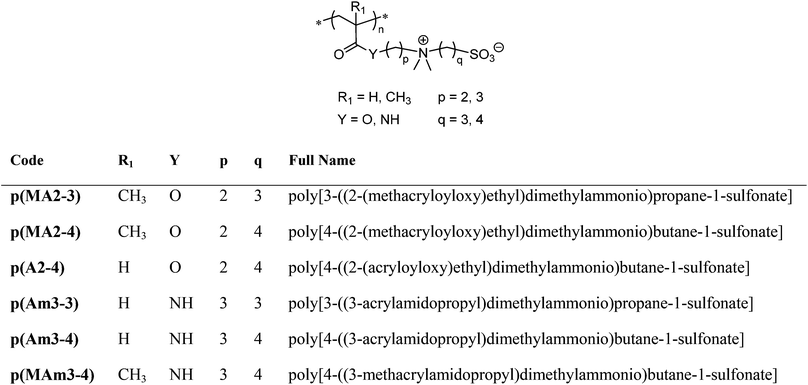 | ||
| Scheme 1 General structure of common sulfobetaine polymers and details and full names of polymers prepared in this study through different synthetic methods. | ||
Method 1: quaternization of tertiary amine functional polymers with sultones
In order to compare the UCST behaviour of SBB with SPB polymers with identical degrees of polymerization, postmodification of tertiary amine functional species with 1,3-propanesultone (PS) and 1,4-butanesultone (BS) was considered first. Arguably the most popular tertiary amine-functional homopolymer is pDMAEMA. Notably, its acrylate sister polymer poly[2-(dimethylamino)ethyl acrylate] suffers from hydrolytic instability51 and is far less commonly employed; this method toward SPB and SBB polymers thus primarily gives access to the methacrylic species p(MA2-3) and p(MA2-4), see Scheme 2.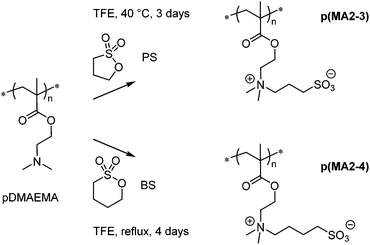 | ||
| Scheme 2 Method 1: synthesis of polysulfobetaines through post-modification of poly[2-(dimethylamino)ethyl methacrylate] (pDMAEMA) with PS and BS in 2,2,2-trifluoroethanol (TFE). | ||
RAFT-made pDMAEMA (DP = 201, ĐM = Mw/Mn = 1.14) was reacted under homogeneous conditions in 2,2,2-trifluoroethanol (TFE) as solvent with 2 equiv. (with respect to amino groups) of PS for 3 days at 40 °C and with 2 equiv. of BS for 4 days under reflux. Excess reagent was removed by adding brine and washing with diethyl ether and product polymers were isolated by dialysis against ultrapure water and analysed by 1H NMR spectroscopy, aqueous size exclusion chromatography (SEC), and turbidity measurements. While the NMR spectrum of the product from pDMAEMA and PS, Fig. 1A, conformed to the expected homo-p(MA2-3), suggesting quantitative conversion, the modification of pDMAEMA with the less reactive BS was found to be only 95% complete, as judged from a residual broad singlet at 2.64 ppm in the 1H NMR spectrum (Fig. 1B) which was assigned to the (CH3)2N– resonance of unreacted DMAEMA segments. Aqueous SEC revealed narrow molecular weight distributions of p(MA2-3) and p[(MA2-4)0.95-co-DMAEMA0.05] predictably similar to that of the pDMAEMA parent, see Fig. 2A and Table 1. The zwitterionic (co)polymers eluted at a similar time, suggesting similar hydrodynamic sizes in the 0.2 M NaCl eluent. The p(MA2-3) sample was found to be soluble in ultrapure water over the entire observed temperature range from 0–90 °C at a concentration of 10 g L−1, not exhibiting the anticipated UCST behaviour. Presumably, in spite of the favourable 1H NMR measurement (Fig. 1A), the modification may not have been quantitative or the pDMAEMA precursor may have suffered hydrolysis/alcoholysis during the extended reaction time. Incomplete betainization of pDMAEMA has been shown to lead to enhanced water solubility (i.e. decreased UCST transitions) due to the hydrophilicity associated with the residual DMAEMA repeat units.52 The butane-spaced sister copolymer p[(MA2-4)0.95-co-DMAEMA0.05], on the other hand and regardless of its incomplete degree of betainization, exhibited a high cloud point of 77.9 °C.
| Product | Reagent | Conversionb (%) | DP |
M
theorn![[thin space (1/6-em)]](https://www.rsc.org/images/entities/char_2009.gif) c (kg mol−1) c (kg mol−1) |
M
SECn![[thin space (1/6-em)]](https://www.rsc.org/images/entities/char_2009.gif) d (kg mol−1) d (kg mol−1) |
Đ M | Cloud pointe (°C) |
|---|---|---|---|---|---|---|---|
| a Degree of polymerization calculated from conversion estimated by 1H NMR measurement of polymerization mixture. b Calculated from 1H NMR analysis. c Molar mass calculated from DP. d Poly(ethylene glycol) equivalent molecular weight and dispersity determined by aqueous SEC. e UCST cloud point measured in ultrapure water at a concentration of 10 g L−1. f Soluble between 0 and 90 °C at a concentration of 10 g L−1. | |||||||
| p(MA2-3) | 1,3-Propanesultone | 100 | 201 | 56.4 | 28 | 1.10 | Sf |
| p[(MA2-4)95-co-DMAEMA5] | 1,4-Butanesultone | 95 | 201 | 59.2 | 27 | 1.11 | 77.9 |
Reduced solubility of SBB species compared to analogous SPBs has been documented for small molecule zwitterionic surfactants and has been speculated to be due to higher hydrophobicity imparted by the additional methylene group in the spacer.26,53,54 Bredas et al.27 found in a theoretical assessment of the aggregation of zwitterionic SPB and SBB end groups in non-polar solvents that SBB head groups (which, same as SPB groups, are usually curled as opposed to in an all-trans conformation)28,29 can more easily adopt an extended conformation when aggregating which makes their dimerization (and aggregation) more favourable than that of SPB groups. To the best of our knowledge, reduced solubility of SBB-functional polymers compared to their SPB counterparts has only very recently been described.22 Given the significantly higher cloud point of the (albeit incompletely modified) MA2-4 copolymer and the resulting potential for UCST tuning (as elaborated above, a reduction of UCST values is easiest to achieve), other routes to SBB (co)polymers were examined.
Method 2: RAFT (co)polymerization of zwitterionic monomers
Polymerization of zwitterionic monomers yields zwitterionic polymers in one step. In addition to monomer MA2-3 used for the preparation of reference polymers, the SBB species MA2-4, A2-4 and MAm3-4 were synthesized in analogy to literature procedures18,49,55 from the respective dimethylamino-functional monomers in acetonitrile with BS in moderate to high yields, Scheme 3.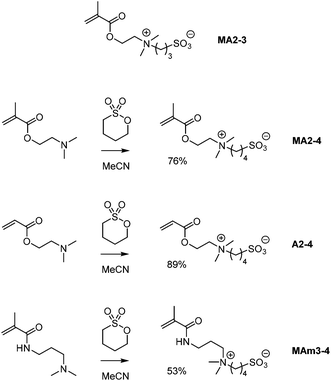 | ||
| Scheme 3 Overview of zwitterionic monomers including the commercially available species MA2-3 and sulfobutylbetaine (SBB) monomers prepared in this study. | ||
RAFT polymerization56 in homogeneous TFE solution using dithioester and trithiocarbonate chain transfer agents (CTAs) was employed to access (co)polymers with predetermined molecular weights with narrow molecular weight distributions, see Scheme 4. Table 2 summarizes conversions, degrees of polymerization (DP, calculated from feed and conversion), aqueous SEC results and cloud points for a series of MA2-3 homopolymers (entries 1–3), a series of MA2-4 homopolymers (entries 5–7), a p(A2-4) species (entry 8), and a series of statistical copolymers p[(MA2-3)x-co-(MA2-4)y] with indices x and y denoting the respective measured molar percentages. Additionally, a sample of p(MA2-3) (entry 4 in Table 2) was prepared using a pentafluorophenyl (PFP)-functional CTA and PFP-functional initiator in propylene carbonate, structures are shown in Scheme 5.
| Entry | Product | Procedurea | Comonomer feedb (mol%) | Target DP | Monomer conversionc (%) | DPd | M theorn (kg mol−1) | M SECn (kg mol−1) | Đ M | Cloud pointe (°C) |
|---|---|---|---|---|---|---|---|---|---|---|
| a Procedure A: CPDB in TFE; B: BPTC in TFE, C: PFP-functional CTA and initiator in propylene carbonate. b Molar ratio of MA2-3–MA2-4 in feed. c (Global) monomer conversion determined by 1H NMR spectroscopy. d Degree of polymerization estimated from conversion. e UCST cloud point measured in ultrapure water at a concentration of 10 g L−1. f Molar copolymer composition determined by 1H NMR spectroscopy. | ||||||||||
| 1 | p(MA2-3) | A | — | 200 | 80 | 161 | 45.2 | 15 | 1.18 | 13.2 |
| 2 | p(MA2-3) | A | — | 230 | 83 | 191 | 53.6 | 17 | 1.13 | 18.8 |
| 3 | p(MA2-3) | A | — | 300 | 92 | 277 | 77.6 | 28 | 1.16 | 35.9 |
| 4 | p(MA2-3) | C | — | 250 | 99 | 248 | 69.7 | 24 | 1.37 | 26.9 |
| 5 | p(MA2-4) | A | — | 130 | 51 | 66 | 19.6 | 11 | 1.16 | 26.5 |
| 6 | p(MA2-4) | A | — | 200 | 77 | 153 | 45.1 | 15 | 1.17 | 64.9 |
| 7 | p(MA2-4) | A | — | 250 | 75 | 186 | 54.8 | 17 | 1.18 | 76.5 |
| 8 | p(A2-4) | B | — | 200 | 92 | 183 | 51.4 | 16 | 1.13 | 52.7 |
| 9 | p[(MA2-3)0.26-co-(MA2-4)0.74] | A | 25![[thin space (1/6-em)]](https://www.rsc.org/images/entities/char_2009.gif) : :![[thin space (1/6-em)]](https://www.rsc.org/images/entities/char_2009.gif) 75 75 |
230 | 80 | 184 | 53.5 | 17 | 1.23 | 63.4 |
| 10 | p[(MA2-3)0.51-co-(MA2-4)0.49] | A | 50![[thin space (1/6-em)]](https://www.rsc.org/images/entities/char_2009.gif) : :![[thin space (1/6-em)]](https://www.rsc.org/images/entities/char_2009.gif) 50 50 |
230 | 82 | 187 | 53.7 | 18 | 1.20 | 47.8 |
| 11 | p[(MA2-3)0.75-co-(MA2-4)0.25] | A | 75![[thin space (1/6-em)]](https://www.rsc.org/images/entities/char_2009.gif) : :![[thin space (1/6-em)]](https://www.rsc.org/images/entities/char_2009.gif) 25 25 |
230 | 83 | 191 | 54.2 | 18 | 1.17 | 35.5 |
Overall, the RAFT synthesis of zwitterionic SPB and SBB (co)polymers from MA2-3, MA2-4, and A2-4 proceeded smoothly in TFE with conversions generally ranging between 75–92% after polymerization at 70 °C overnight. (Co)polymer products had low measured dispersities of ĐM ≤ 1.23, with the exception of one p(MA2-3) sample that proceeded to 99% monomer conversion and had a ĐM of 1.37. Exemplary molecular weight distribution curves obtained by aqueous SEC of the series of MA2-4 homopolymers are plotted in Fig. 2B showing increasing hydrodynamic sizes with increasing DPs. Since SEC yields only apparent molecular weights, the absolute molecular weight of an exemplary sample, p(MA2-4) with a calculated DP of 66 (Table 2, entry 5), was estimated by end group analysis. A solution of this polymer in 2,2,2-trifluoroethanol at a concentration of 1.0 g L−1 was found to have an absorbance maximum of A = 0.63 at a wavelength of 308 nm which was attributed to a π–π* absorption band of the dithioester end group.57 Using the tabulated maximum molar absorptivity of a model RAFT agent, 4-cyano-4-(phenylcarbonothioylthio)pentanoic acid, of ε = 13![[thin space (1/6-em)]](https://www.rsc.org/images/entities/char_2009.gif) 200 L mol−1 cm−1, measured in methanol,57 as reference, an absolute molecular weight Mn = 21.0 kg mol−1 was obtained, in reasonable agreement with the theoretical value of 19.6 kg mol−1. Notably, this calculation assumes (i) equal absorbivities of the dithioester group of the model RAFT agent in methanol and the dithioester end group of the zwitterionic polymer in 2,2,2-trifluoroethanol and (ii) every polymer chain has an intact dithioester end group. All 1H NMR spectra conformed to the expected representative homo- and copolymer structures; Fig. 1 shows exemplary spectra of p(MA2-3) (spectrum C) and p(MA2-4) (spectrum D) samples and copolymer p[(MA2-3)0.51-co-(MA2-4)0.49]. Note the striking similarity between spectra C and A and spectra D and B, the latter with the exception of the above-mentioned residual DMAEMA resonance. RAFT polymerization of the methacrylamide derivative MAm3-4, however, gave only very low conversions employing BPTC or CPBP as the mediating CTAs. Low conversion of the MAm3-3 analogue using a dithiobenzoate RAFT agent was previously observed by others;36 while Hildebrand et al.,31 for example, described high conversions of MAm3-3 using a 4-cyano-4-[(phenylethylsulfanylthiocarbonyl)sulfanyl]pentanoic acid derivative.
200 L mol−1 cm−1, measured in methanol,57 as reference, an absolute molecular weight Mn = 21.0 kg mol−1 was obtained, in reasonable agreement with the theoretical value of 19.6 kg mol−1. Notably, this calculation assumes (i) equal absorbivities of the dithioester group of the model RAFT agent in methanol and the dithioester end group of the zwitterionic polymer in 2,2,2-trifluoroethanol and (ii) every polymer chain has an intact dithioester end group. All 1H NMR spectra conformed to the expected representative homo- and copolymer structures; Fig. 1 shows exemplary spectra of p(MA2-3) (spectrum C) and p(MA2-4) (spectrum D) samples and copolymer p[(MA2-3)0.51-co-(MA2-4)0.49]. Note the striking similarity between spectra C and A and spectra D and B, the latter with the exception of the above-mentioned residual DMAEMA resonance. RAFT polymerization of the methacrylamide derivative MAm3-4, however, gave only very low conversions employing BPTC or CPBP as the mediating CTAs. Low conversion of the MAm3-3 analogue using a dithiobenzoate RAFT agent was previously observed by others;36 while Hildebrand et al.,31 for example, described high conversions of MAm3-3 using a 4-cyano-4-[(phenylethylsulfanylthiocarbonyl)sulfanyl]pentanoic acid derivative.
All RAFT-made (co)polymers showed sharp, fully reversible and reproducible UCST transitions with a hysteresis of ∼3 °C, see Fig. S1 in the ESI.† The significant impact of the ion bridge length on the aqueous solution behaviour was apparent from a comparison of the p(MA2-4) series with the homologous p(MA2-3) reference series. A plot of their cloud points vs. their DP, shown in Fig. 3, supported the following observations: over the observed DP range, the UCST cloud point (CP) increases in a linear fashion with DP for both series. The CP increases more strongly with the DP for the SBB homopolymers, linear fits giving CPSBB/°C = 0.42 × DP − 0.96 for the p(MA2-4) series and CPSPB/°C = 0.20 × DP – 18.5 for the p(MA2-3) series. Thus, when comparing homopolymers of the same length, p(MA2-4) has significantly higher cloud points than p(MA2-3). The cloud point of the p(MA2-3) sample prepared with a different end group (entry 4 in Table 2) coincided with the trend of its sister polymers, indicating only small end group influence on the UCST transition at this DP. These observations suggest that, with regards to exploiting aqueous UCST behaviour, the investigated SBB species present a clear advantage over their SPB homologues. To reiterate, most manipulations of the aqueous solvent or the chemical structure of polysulfobetaines such as inclusion of hydrophilic (or certain hydrophobic)43 groups bring about a decrease of UCST cloud points necessitating scaffolds with fundamentally high UCST transitions in pure water. Judging from the plot in Fig. 3, aqueous UCST cloud points around body temperature can be realized with p(MA2-4) with an easily achievable DP of ∼100, while, in agreement with literature,21,35 significantly higher DPs are necessary for p(MA2-3) to achieve similarly high cloud points.
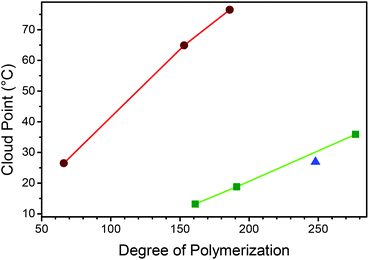 | ||
| Fig. 3 UCST cloud point versus degree of polymerization for p(MA2-3) (green squares) and p(MA2-4) (red circles) prepared by RAFT in 2,2,2-trifluoroethanol using CPDB as chain transfer agent and of p(MA2-3) made by RAFT in propylene carbonate using the activated ester CTA (Scheme 5) (blue triangle). Lines are added to guide the eye. | ||
The aqueous solution behaviour of the SBB acrylate species p(A2-4) (DP = 183) was also assessed and compared to p(MA2-4) (DP = 186) and p(MA2-3) (DP = 191) with similar degrees of polymerization. A temperature–concentration phase diagram, showing the boundary between the two-phase (below the curve) and the one-phase region (above the curve), shown in Fig. 4, made evident the similar shape of the phase separation boundaries with flat regions above concentrations of ∼10 g L−1 for all three zwitterionic polymers. Of note, the acrylic polymer p(A2-4) exhibiting a cloud point of 52.7 °C at a concentration of 10 g L−1 was more water soluble than the methacrylic analogue p(MA2-4) (CP = 76.5 °C at the same concentration) but less soluble than the SPB derivative p(MA2-3) (CP = 18.8 °C), indicating that the UCST is influenced much more sensitively by formal addition of a methylene segment to the ion bridge rather than to the backbone. This observation thus corroborated the notion of improved electrostatic interlocking efficiency of butyl-spaced zwitterionic groups due to higher flexibility of the of the butyl chains and their stronger tendency to adopt an extended conformation as compared to the propyl analogues.27
Comparison of the RAFT-made homopolymer series with those obtained from post-modification of pDMAEMA suggested an influence of the synthetic method on the UCST behaviour. Judging from the linear fit of CP vs. DP for the RAFT-made p(MA2-3) series, Fig. 3, the pDMAEMA-made sample with a DP of 201 would be expected to have a CP of around 22 °C, but was, as mentioned above, fully soluble. This comparison suggested that (for the chosen reaction conditions) the modification of pDMAEMA with sultones was not ideal with regards to obtaining (high) UCST transitions. In order to assess the scope and limitations of direct polymerization of zwitterionic monomers, two further experiments were conducted.
Firstly, the modification of polymer end groups is of great importance for the construction of defined polymeric architectures including diblock copolymers, surface-tethered brushes, or hybrid materials. RAFT polymerization was thus attempted with an activated ester CTA and activated ester initiator, as shown in Scheme 5. This approach produces polymers with one activated pentafluorophenol (PFP) end group providing access to simple modification with amines.46,58 The reactive CTA and initiator were, however, not soluble in water and were found to react, at elevated polymerization temperatures, with TFE. Therefore, propylene carbonate was used as a non-protic solvent in which monomer MA2-3 was moderately soluble, while, remarkably, MA2-4, was poorly soluble. Polymerization of MA2-3 thus yielded a homopolymer with a reactive end group which possessed UCST characteristics with a cloud point in good agreement with those of the series polymerized in TFE, see Fig. 3. Addition of an amine-functional dye to a propylene carbonate solution of the reactive end group-functional polymer followed by purification yielded an orange-coloured solid that dissolved in (warm) water with yellow colour, see Scheme 5. This experiment demonstrated successful RAFT polymerization of a zwitterionic SPB monomer with a reactive CTA in a non-protic solvent and provided qualitative evidence of successful end group modification with a hydrophobic dye. However, though advantageous with respect to higher UCST transitions, the low compatibility of the SBB MA2-4 with non-protic solvents poses limitations for the incorporation of water/TFE sensitive or insoluble species into MA2-4-based (co)polymers.
Secondly, a series of copolymers of MA2-3 and MA2-4 with comparable DPs (184–191) and SEC-measured apparent molar masses was prepared by RAFT radical polymerization in TFE. Copolymer compositions, determined by 1H NMR spectroscopy (see Fig. 1E) and listed in Table 2, matched very well with the comonomer feed ratio, indicating the formation of copolymers with predetermined molar compositions. Determination of their aqueous solution behaviour revealed a linear increase of cloud points with MA2-4 comonomer content, Fig. 5, suggesting a convenient and simple methodology for tuning of UCST transitions at a constant chain length.
Method 3: post-modification of activated ester precursors with zwitterionic amines
Previously, we described the acyl substitution of poly(pentafluorophenyl acrylate) (pPFPA) with an amino-functional SPB, amine3-3 (shown in Scheme 6), as a versatile route toward series of SPB acrylamide (co)polymers with identical DPs including hydrophobically modified copolymers with tuneable UCSTs.43 Key to this procedure was the solubility of all involved species—pPFPA precursor, zwitterionic amine, and (co)polymer product—in propylene carbonate (PC). In this approach the introduction of zwitterionic side groups does not rely on the reactivity of different sultones (as in the non-quantitative modification of pDMAEMA with BS giving ill-defined SBB species). Therefore, we next investigated the postpolymerization synthesis of SBB (co)polymers from polymeric activated ester precursors. For this purpose, a novel zwitterionic amine, 4-((3-aminopropyl)dimethylammonio)butane-1-sulfonate, amine3-4, was prepared in three steps starting from N,N-dimethylaminopropylamine by (i) BOC-protection of the primary amine, (ii) quaternization of the dimethylamino group with BS in THF, followed by (iii) deprotection of the primary amine. Purification of the first intermediate, tert-butyl (3-(dimethylamino)propyl)carbamate by column chromatography (in spite of reasonably clean 1H and 13C NMR spectra of the crude product), was found to facilitate the isolation of the desired amine3-4 reagent in high purity without the need for time-consuming recrystallization, Fig. 6. Showing a similar trend as monomers MA2-3 and MA2-4, this amine-functional SBB reagent was somewhat less soluble in PC than the SPB analogue necessitating heating in order to dissolve. Notably, however, unlike pPFPA, the generally less reactive59,60 methacrylate sister precursor poly(pentafluorophenyl methacrylate) was found to be poorly soluble in (hot) PC. This method toward zwitterionic (co)polymers thus primarily gives straightforward access to acrylamido betaine derivatives.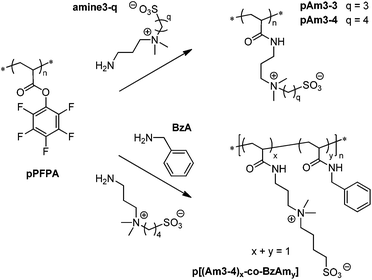 | ||
| Scheme 6 Method 3: zwitterionic homo- and copolymers through postpolymerization modification of poly(pentafluorophenyl acrylate) (pPFPA) with zwitterionic amines and benzylamine. | ||
RAFT-prepared pPFPA with a DP of 178 and ĐM = 1.23 was used as the activated precursor for all modifications. Aside from requiring more heat for initial dissolution of the small molecule reagent, the synthesis of zwitterionic homo- and copolymers from pPFPA with amine3-4 did not differ from the previously described protocol43 and details of the synthesis and characterization are only briefly discussed here. A 1.5-fold excess of (a mixture of) amines dissolved in PC was added to a PC solution of pPFPA and the mixture was stirred overnight. Full substitution was confirmed by 19F NMR analysis (Fig. S2†) before product (co)polymers were purified by dialysis and isolated. In addition to a p(Am3-3) reference homopolymer and its SBB homologue p(Am3-4), a series of copolymers containing benzylacrylamide units, p[(Am3-4)x-co-BzAmy], with varying molar compositions was prepared by employing mixtures of amine3-4 and benzylamine, see Table 3. Characterization by 1H NMR (exemplary spectrum of p(Am3-4) shown in Fig. 1F) and FT-IR spectroscopy (Fig. 7) conformed to the expected zwitterionic (co)polymer structures. Aqueous SEC of p(Am3-3) and p(Am3-4), shown in Fig. 2C, revealed size distributions predictably similar to their pPFPA parent with both zwitterionic daughter homopolymers having very similar hydrodynamic sizes in the 0.2 M aq. NaCl eluent. Due to low solubility, the benzylacrylamide (BzAM) copolymers were not characterized by SEC.
| Product, copolymer composition | DP | Amine 1 (feed, mol%) | Amine 2 (feed, mol%) | M theorn (kg mol−1) | M SECn (kg mol−1) | Đ SECM | Cloud point (°C) |
|---|---|---|---|---|---|---|---|
| a Molar copolymer composition determined by 1H NMR spectroscopy. b Not determined due to limited solubility in eluent. c Insoluble in pure water, but UCST behaviour in aqueous NaCl solutions. d Insoluble in pure water and in concentrated NaCl solutions between 0 and 90 °C at a concentration of 10 g L−1. | |||||||
| p(Am3-3) | 178 | amine3-3 (100) | — | 49.8 | 30 | 1.32 | 13.3 |
| p(Am3-4) | 178 | amine3-4 (100) | — | 52.3 | 31 | 1.29 | 58.8 |
| p[(Am3-4)0.50-co-BzAm0.50] | 178 | amine3-4 (50) | BzA (50) | 40.6 | n.d.b | n.d. | NaCl (aq).c |
| p[(Am3-4)0.38-co-BzAm0.62] | 178 | amine3-4 (35) | BzA (65) | 37.8 | n.d. | n.d. | NaCl (aq).c |
| p[(Am3-4)0.31-co-BzAm0.69] | 178 | amine3-4 (25) | BzA (75) | 36.2 | n.d. | n.d. | Id |
The SBB homopolymer p(Am3-4) showed a sharp, reproducible phase transition with a hysteresis of ∼3 °C, similar to that of RAFT-made poly(meth)acrylates, see Fig. S1.† With a cloud point of 58.8 °C, this species had a considerably higher phase transition temperature than p(Am3-3) (cloud point 13.3 °C) suggesting again an advantage of this SBB species with regards to achieving (tuneable) UCST behaviour. Comparing samples with similar DPs (178–191) of all five zwitterionic species investigated here, we find increasing cloud points in the order: p(Am3-3) ≈ p(MA2-3) ≪ p(A2-4) ≈ p(Am3-4) ≪ p(MA2-4). Cloud points found here for p(MA2-3) were in general agreement with recently reported values of similar homopolymers35 while we note the similarity between the cloud points of p(Am3-3) (DP = 178, CP = 13.3 °C) and p(MAm3-3) (reported by others,31 DP = 170, CP = 11.0 °C) suggesting a less prominent effect of the backbone methyl group in this case and/or an effect of the synthetic method.
Aside from increasing the ion bridge from a propyl to a butyl spacer, the introduction of benzylacrylamide comonomer units provides an additional handle to increase UCST transitions and the maximum salt concentration at which UCST behaviour can be observed. The cloud point dependency of the SPB copolymer p[(Am3-3)0.47-co-BzAm0.53] as a function of NaCl concentration, taken from the literature,43 is plotted in Fig. 8A, indicating full solubility at [NaCl] > ∼80 mM. Here, a series of SBB copolymers with molar BzAm contents of 50%, 62%, and 69%, as determined by 1H NMR spectroscopy in 500 mM NaCl in D2O, was prepared. Notably, sample p[(Am3-4)0.31-co-BzAm0.69] with the highest BzAm content did not form a clear solution in this solvent (nor at higher NaCl concentrations)—the determined composition may thus be less accurate—indicating an upper limit of observable zwitterionic behaviour for hydrophobic modification. The remaining two samples, however, while being insoluble in pure (hot) water, did exhibit sharp, reversible UCST transitions between clear solutions and cloudy mixtures in aqueous NaCl solution. As expected, the phase behaviour of these samples extended to higher NaCl concentrations than for the SPB copolymer, with UCST transitions measured on solutions containing up to 128 mM (7.5 g L−1) NaCl for p[(Am3-4)0.50-co-BzAm0.50] and 154 mM (9.0 g L−1, concentration of isotonic saline) NaCl for p[(Am3-4)0.38-co-BzAm0.62], see Fig. 8. These results demonstrate that the combination of SBB side chains with hydrophobic modification further increases the temperature/salt range in which sharp UCST transitions can be achieved. Specifically, UCST transitions of zwitterionic copolymers at a physiological NaCl concentration are promising for the exploitation of such smart materials in biomedical applications. However, the complex composition of biological fluids and the strong dependence of the UCST phase behaviour on the type of ions20,21,23,31 or, likely, other solutes needs to be considered. In the present case, for example, p[(Am3-4)0.38-co-BzAm0.62] was found to remain soluble in phosphate buffered saline (137 mM NaCl, 2.7 mM KCl, 10 mM Na2HPO4, 1.8 mM KH2PO4) and HEPES buffer (150 mM NaCl, 10 mM 4-(2-hydroxyethyl)-1-piperazineethanesulfonic acid) when cooled to 0 °C. Conversely, this strong dependence of the phase behaviour on potentially minute changes of the environment may be exploited for the development of materials that respond selectively to specific biological microenvironments with (slightly) different ion concentrations.
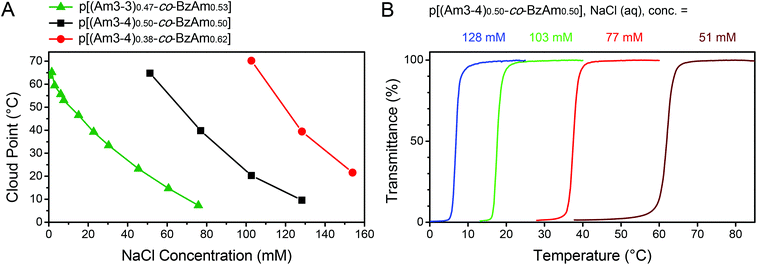 | ||
| Fig. 8 Influence of NaCl concentration on the phase separation temperature of p(Am3-4)-benzylacrylamide copolymers; (A) plot of UCST cloud point versus NaCl concentration for p[(Am3-3)0.47-co-BzAm0.53] (values taken from our previous study)43 (green triangles), and the SBB species prepared here p[(Am3-4)0.50-co-BzAm0.50] (black squares) and p[(Am3-4)0.38-co-BzAm0.62] (red circles); (B) exemplary turbidity curves for p[(Am3-4)0.50-co-BzAm0.50] at different NaCl concentrations. | ||
Conclusion
A detailed comparative study of the aqueous solution behaviour of sulfobutylbetaine (SBB) (co)polymers was presented. In all cases, samples showed significantly higher UCST transitions, i.e. they were less soluble in water, than their respective sulfopropylbetaine (SPB) counterparts. Whereas the UCST transitions of the common SPB homopolymers p(MA2-3) and p(MAm3-3) are limited to relatively high molecular weight samples and/or to solutions in ultrapure water, the corresponding SBB-functional homopolymers investigated here offer a much larger temperature and salt concentration range for observing sharp, reproducible UCST transitions. Scope and limitations of three different synthetic techniques toward SBB homo- and copolymers were compared. The quaternization of pDMAEMA with 1,4-butanesultone in 2,2,2-trifluoroethanol (TFE) suffered from low reactivity of this alkylating agent resulting in incomplete modification making this procedure less attractive for the synthesis of pristine SBB species. RAFT radical polymerization of SBB-functional (meth)acrylate monomers and their copolymerization with SPB monomers in TFE proceeded smoothly with high conversions, low measured dispersities ĐM, and facilitated access to a series of (co)polymers with cloud points from 13.2–76.5 °C. Low compatibility of SBB-functional monomers with non-protic solvents including propylene carbonate (PC), however, limits the incorporation of non-polar or alcohol/water-sensitive components in this method. Post-modification of poly(pentafluorophenyl acrylate) with a SBB-functional amine in PC provided zwitterionic polyacrylamides and allowed for the introduction of hydrophobic comonomer units, but required the multi-step synthesis of the amine reagent. A SBB-functional copolymer containing 62 mol% of benzylacrylamide comonomer units showed UCST behaviour up to a physiological concentration of 9 g L−1 NaCl making such materials promising for exploiting their smart behaviour in the biomedical arena.Funding sources
P. J. R. acknowledges funding from the University of New South Wales (UNSW) and the Australian Research Council (ARC) through a Discovery Early Career Researcher Award (DE120101547).References
- M. A. C. Stuart, W. T. S. Huck, J. Genzer, M. Muller, C. Ober, M. Stamm, G. B. Sukhorukov, I. Szleifer, V. V. Tsukruk, M. Urban, F. Winnik, S. Zauscher, I. Luzinov and S. Minko, Nat. Mater., 2010, 9, 101–113 CrossRef PubMed.
- J. Seuring and S. Agarwal, Macromol. Rapid Commun., 2012, 33, 1898–1920 CrossRef CAS PubMed.
- S. Kudaibergenov, W. Jaeger and A. Laschewsky, in Supramolecular Polymers Polymeric Betains Oligomers, Springer, Berlin/Heidelberg, 2006, vol. 201, pp. 157–224 Search PubMed.
- A. B. Lowe and C. L. McCormick, Chem. Rev., 2002, 102, 4177–4190 CrossRef CAS PubMed.
- F. Xuan and J. Liu, Polym. Int., 2009, 58, 1350–1361 CrossRef CAS.
- A. Laschewsky, Polymers, 2014, 6, 1544–1601 CrossRef CAS.
- G. Gunkel and W. T. S. Huck, J. Am. Chem. Soc., 2013, 135, 7047–7052 CrossRef CAS PubMed.
- J. Wu, W. Lin, Z. Wang, S. Chen and Y. Chang, Langmuir, 2012, 28, 7436–7441 CrossRef CAS PubMed.
- Q. Sun, Y. Su, X. Ma, Y. Wang and Z. Jiang, J. Membr. Sci., 2006, 285, 299–305 CrossRef CAS.
- Y. Chang, Y.-J. Shih, C.-J. Lai, H.-H. Kung and S. Jiang, Adv. Funct. Mater., 2013, 23, 1100–1110 CrossRef CAS.
- J. Yuan, X. Huang, P. Li, L. Li and J. Shen, Polym. Chem., 2013, 4, 5074–5085 RSC.
- R. Lalani and L. Liu, Biomacromolecules, 2012, 13, 1853–1863 CrossRef CAS PubMed.
- R. Hart and D. Timmerman, J. Polym. Sci., 1958, 28, 638–640 CrossRef CAS.
- P. Köberle, A. Laschewsky and D. van den Boogaard, Polymer, 1992, 33, 4029–4039 CrossRef.
- P. Koeberle and A. Laschewsky, Macromolecules, 1994, 27, 2165–2173 CrossRef CAS.
- V. M. Monroy Soto and J. C. Galin, Polymer, 1984, 25, 121–128 CrossRef CAS.
- J. C. Salamone, W. Volksen, S. C. Israel, A. P. Olson and D. C. Raia, Polymer, 1977, 18, 1058–1062 CrossRef CAS.
- D. Kratzer, L. Barner, C. Friedmann, S. Bräse and J. Lahann, Eur. J. Org. Chem., 2014, 8064–8071 CrossRef CAS.
- M. B. Huglin and M. A. Radwan, Polym. Int., 1991, 26, 97–104 CrossRef CAS.
- P. Köberle, A. Laschewsky and T. D. Lomax, Die Makromolekulare Chemie, Rapid Commun., 1991, 12, 427–433 CrossRef.
- P. Mary, D. D. Bendejacq, M.-P. Labeau and P. Dupuis, J. Phys. Chem. B, 2007, 111, 7767–7777 CrossRef CAS PubMed.
- J. Ning, G. Li and K. Haraguchi, Macromolecules, 2013, 46, 5317–5328 CrossRef CAS.
- D. N. Schulz, D. G. Peiffer, P. K. Agarwal, J. Larabee, J. J. Kaladas, L. Soni, B. Handwerker and R. T. Garner, Polymer, 1986, 27, 1734–1742 CrossRef CAS.
- V. A. Vasantha, S. Jana, A. Parthiban and J. G. Vancso, Chem. Commun., 2014, 50, 46–48 RSC.
- A. Bieglé, A. Mathis and J.-C. Galin, Macromol. Chem. Phys., 2000, 201, 113–125 CrossRef.
- R. G. Laughlin, Langmuir, 1991, 7, 842–847 CrossRef CAS.
- J. L. Bredas, R. R. Chance and R. Silbey, Macromolecules, 1988, 21, 1633–1639 CrossRef CAS.
- Y. Chevalier and P. Le Perchec, J. Phys. Chem., 1990, 94, 1768–1774 CrossRef CAS.
- M. Galin, A. Chapoton and J.-C. Galin, J. Chem. Soc., Perkin Trans. 2, 1993, 545–553 RSC.
- L. Chen, Y. Honma, T. Mizutani, D. J. Liaw, J. P. Gong and Y. Osada, Polymer, 2000, 41, 141–147 CrossRef CAS.
- V. Hildebrand, A. Laschewsky and D. Zehm, J. Biomater. Sci., Polym. Ed., 2014, 25, 1602–1618 CrossRef CAS PubMed.
- V. M. Monroy Soto and J. C. Galin, Polymer, 1984, 25, 254–262 CrossRef.
- Y.-J. Shih, Y. Chang, A. Deratani and D. Quemener, Biomacromolecules, 2012, 13, 2849–2858 CrossRef CAS PubMed.
- M. Tian, J. Wang, E. Zhang, J. Li, C. Duan and F. Yao, Langmuir, 2013, 29, 8076–8085 CrossRef CAS PubMed.
- H. Willcock, A. Lu, C. F. Hansell, E. Chapman, I. R. Collins and R. K. O'Reilly, Polym. Chem., 2014, 5, 1023–1030 RSC.
- M. Arotcarena, B. Heise, S. Ishaya and A. Laschewsky, J. Am. Chem. Soc., 2002, 124, 3787–3793 CrossRef CAS PubMed.
- Y. Pei, J. Travas-Sejdic and D. E. Williams, Langmuir, 2012, 28, 8072–8083 CrossRef CAS PubMed.
- M. S. Donovan, B. S. Sumerlin, A. B. Lowe and C. L. McCormick, Macromolecules, 2002, 35, 8663–8666 CrossRef CAS.
- V. Strehmel, H. Wetzel, A. Laschewsky, E. Moldenhauer and T. Klein, Polym. Adv. Technol., 2008, 19, 1383–1390 CrossRef CAS.
- A. B. Lowe, N. C. Billingham and S. P. Armes, Chem. Commun., 1996, 1555–1556 RSC.
- A. B. Lowe, N. C. Billingham and S. P. Armes, Macromolecules, 1999, 32, 2141–2148 CrossRef CAS.
- J. V. M. Weaver, S. P. Armes and V. Butun, Chem. Commun., 2002, 2122–2123 RSC.
- P. A. Woodfield, Y. C. Zhu, Y. W. Pei and P. J. Roth, Macromolecules, 2014, 47, 750–762 CrossRef CAS.
- R. Kakuchi and P. Theato, in Functional Polymers by Post-Polymerization Modification, Wiley-VCH Verlag GmbH & Co. KGaA, 2012, pp. 45–64 Search PubMed.
- J. Y. Quek, P. J. Roth, R. A. Evans, T. P. Davis and A. B. Lowe, J. Polym. Sci., Part A: Polym. Chem., 2013, 51, 394–404 CrossRef CAS.
- P. J. Roth, K. T. Wiss, R. Zentel and P. Theato, Macromolecules, 2008, 41, 8513–8519 CrossRef CAS.
- R. Nudelman, O. Ardon, Y. Hadar, Y. Chen, J. Libman and A. Shanzer, J. Med. Chem., 1998, 41, 1671–1678 CrossRef CAS PubMed.
- P. J. Roth, J. Y. Quek, Y. Zhu, B. M. Blunden and A. B. Lowe, Chem. Commun., 2014, 50, 9561–9564 RSC.
- M. Gauthier, T. Carrozzella and A. Penlidis, J. Polym. Sci., Part A: Polym. Chem., 2002, 40, 511–523 CrossRef CAS.
- P. J. Roth, C. Boyer, A. B. Lowe and T. P. Davis, Macromol. Rapid Commun., 2011, 32, 1123–1143 CrossRef CAS PubMed.
- P. van de Wetering, N. J. Zuidam, M. J. van Steenbergen, O. A. G. J. van der Houwen, W. J. M. Underberg and W. E. Hennink, Macromolecules, 1998, 31, 8063–8068 CrossRef CAS.
- H.-Y. Tian, J.-J. Yan, D. Wang, C. Gu, Y.-Z. You and X.-S. Chen, Macromol. Rapid Commun., 2011, 32, 660–664 CrossRef CAS PubMed.
- P. G. Faulkner, A. J. I. Ward and D. W. Osborne, Langmuir, 1989, 5, 924–926 CrossRef CAS.
- J. G. Weers, J. F. Rathman, F. U. Axe, C. A. Crichlow, L. D. Foland, D. R. Scheuing, R. J. Wiersema and A. G. Zielske, Langmuir, 1991, 7, 854–867 CrossRef CAS.
- W. Ding, C. Lv, Y. Sun, X. Liu, T. Yu, G. Qu and H. Luan, J. Polym. Sci., Part A: Polym. Chem., 2011, 49, 432–440 CrossRef CAS.
- G. Moad, E. Rizzardo and S. H. Thang, Aust. J. Chem., 2012, 65, 985–1076 CrossRef CAS.
- K. Skrabania, A. Miasnikova, A. M. Bivigou-Koumba, D. Zehm and A. Laschewsky, Polym. Chem., 2011, 2, 2074–2083 RSC.
- P. J. Roth, F. D. Jochum, F. R. Forst, R. Zentel and P. Theato, Macromolecules, 2010, 43, 4638–4645 CrossRef CAS.
- G. B. H. Chua, P. J. Roth, H. T. T. Duong, T. P. Davis and A. B. Lowe, Macromolecules, 2012, 45, 1362–1374 CrossRef CAS.
- M. I. Gibson, E. Frohlich and H.-A. Klok, J. Polym. Sci., Part A: Polym. Chem., 2009, 47, 4332–4345 CrossRef CAS.
Footnotes |
| † Electronic supplementary information (ESI) available: Heating and cooling curves showing reproducibility and hysteresis, 19F NMR measurements indicating full conversion of PFP precursors. See DOI: 10.1039/c5py00160a |
| ‡ Present address: Nanochemistry Research Institute (NRI), Department of Chemistry, Curtin University, Bentley, Perth WA 6102, Australia. |
| This journal is © The Royal Society of Chemistry 2015 |

